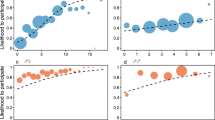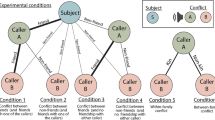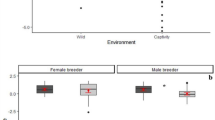Abstract
Reciprocal altruism refers to the exchange of beneficial acts between individuals, in which the benefits to the recipient exceed the cost to the altruist. Theory predicts that cooperation among unrelated animals can occur whenever individuals encounter each other regularly and are capable of adjusting their cooperative behaviour according to experience1. Although the potential for reciprocal altruism exists in many animal societies, most interactions occur between closely related individuals, and examples of reciprocity among non-kin are rare2,3. The field experiments on vervet monkeys which we present here demonstrate that grooming between unrelated individuals increases the probability that they will subsequently attend to each others' solicitations for aid. Vervets appear to be more willing to aid unrelated individuals if those individuals have behaved affinitively toward them in the recent past. In contrast, recent grooming between close genetic relatives appears to have no effect on their willingness to respond to each other's solicitations for aid.
This is a preview of subscription content, access via your institution
Access options
Subscribe to this journal
Receive 51 print issues and online access
$199.00 per year
only $3.90 per issue
Buy this article
- Purchase on Springer Link
- Instant access to full article PDF
Prices may be subject to local taxes which are calculated during checkout
Similar content being viewed by others
References
Trivers, R. L. Q. Rev. Biol. 46, 35–57 (1971).
Packer, C. Nature 265, 441–443 (1977).
de Waal, F. Chimpanzee Politics (Harper & Row, New York, 1982).
Cheney, D. L. Behav. Ecol. Sociobiol. 2, 303–318 (1977).
Cheney, D. L. in Primate Social Relationships (ed. Hinde, R. A.) (Blackwell, Oxford, 1983).
Kurland, J. A. Contr. Primatol. 12, 1–145 (1977).
Massey, A. Behav. Ecol. Sociobiol. 2, 31–40 (1977).
Seyfarth, R. M. J. theor. Biol. 65, 671–698 (1977).
Chalmers, N. Social Behaviour in Primates (Arnold, London, 1979).
Stammbach, E. Behaviour 67, 322–338 (1978).
Chapais, B. & Schulman, S. R. J. theor. Biol. 82, 47–89 (1980).
Fairbanks, L. Anim. Behav. 28, 853–859 (1980).
Seyfarth, R. M. Anim. Behav. 28, 798–813 (1980).
Silk, J. B. et al. Behaviour 78, 111–137 (1981).
Struhsaker, T. T. in Social Communication among Primates (ed. Altmann, S.) 281–324 (University of Chicago Press, 1967).
Cheney, D. L. & Seyfarth, R. M. Anim. Behav. 28, 362–367 (1980).
Cheney, D. L. & Seyfarth, R. M. Anim. Behav. 30, 739–751 (1982).
Axelrod, R. & Hamilton, W. D. Science 211, 1390–1396 (1981).
Gouzoules, S. et al. Anim. Behav. 32, 182–193 (1984).
Hamilton, W. D. J. theor. Biol. 7, 1–52 (1964).
Author information
Authors and Affiliations
Rights and permissions
About this article
Cite this article
Seyfarth, R., Cheney, D. Grooming, alliances and reciprocal altruism in vervet monkeys. Nature 308, 541–543 (1984). https://doi.org/10.1038/308541a0
Received:
Accepted:
Issue Date:
DOI: https://doi.org/10.1038/308541a0
This article is cited by
-
Grooming reciprocity in Geoffroy’s spider monkeys, and the influence of the opportunity of interaction
Behavioral Ecology and Sociobiology (2024)
-
Social Interactions in Wild Black-Fronted Titi Monkeys (Callicebus nigrifrons)
International Journal of Primatology (2023)
-
Men increase time spent on a charitable task when in the presence of women and other men: Evidence of competitive altruism in online mating scenarios
Current Psychology (2023)
-
Observations of flipper rubbing in mother–calf pairs of captive bottlenose dolphins (Tursiops truncatus) suggest a body-surface care function
Journal of Ethology (2022)
-
Do immigrant female bonobos prefer older resident females as important partners when integrating into a new group?
Primates (2022)
Comments
By submitting a comment you agree to abide by our Terms and Community Guidelines. If you find something abusive or that does not comply with our terms or guidelines please flag it as inappropriate.



